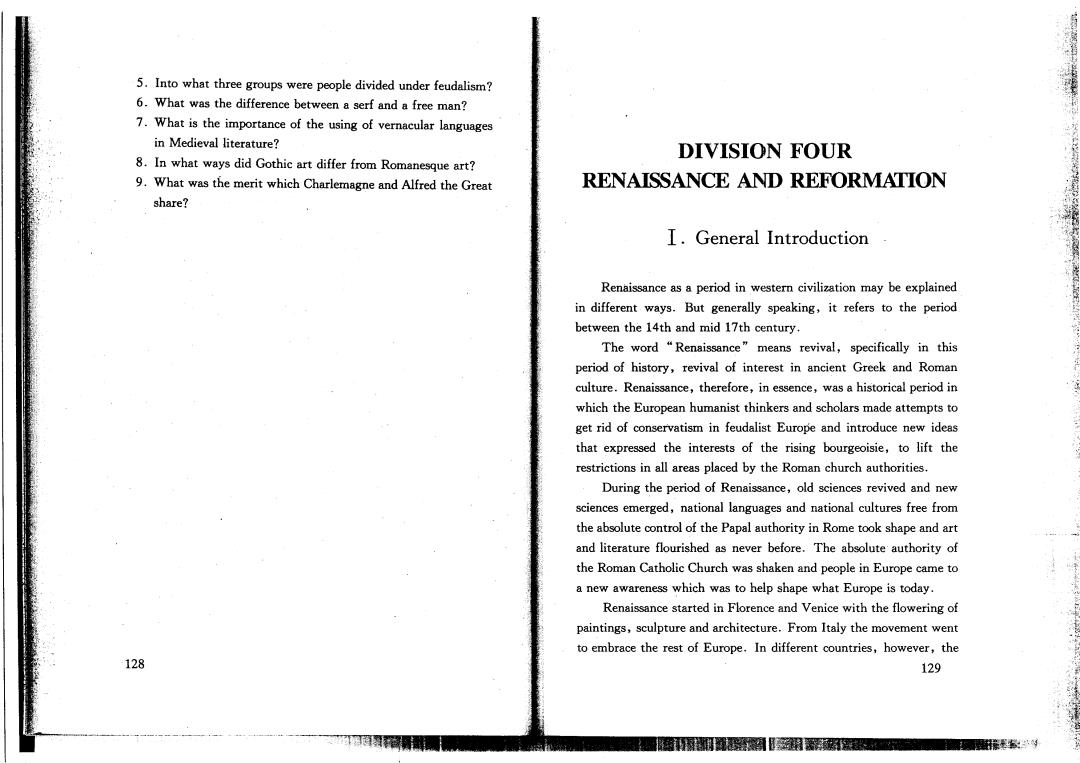
5.Into what three groups were people divided under feudalism? 6.What was the difference between a serf and a free man? 7.What is the importance of the using of vernacular languages in Medieval literature? DIVISION FOUR 8.In what ways did Gothic art differ from Romanesque art? 9.What was the merit which Charlemagne and Alfred the Great RENAISSANCE AND REFORMATION share? I.General Introduction 、 Renaissance as a period in western civilization may be explained in different ways.But generally speaking,it refers to the period between the 14th and mid 17th century. The word "Renaissance"means revival,specifically in this period of history,revival of interest in ancient Greek and Roman culture.Renaissance,therefore,in essence,was a historical period in which the European humanist thinkers and scholars made attempts to get rid of conservatism in feudalist Europe and introduce new ideas that expressed the interests of the rising bourgeoisie,to lift the restrictions in all areas placed by the Roman church authorities. During the period of Renaissance,old sciences revived and new sciences emerged,national languages and national cultures free from the absolute control of the Papal authority in Rome took shape and art and literature flourished as never before.The absolute authority of the Roman Catholic Church was shaken and people in Europe came to a new awareness which was to help shape what Europe is today. Renaissance started in Florence and Venice with the flowering of paintings,sculpture and architecture.From Italy the movement went to embrace the rest of Europe.In different countries,however,the 128 129 理糯是款:好

movement occurred in different periods with different emphasis. Where the impact with Italy was most strongly felt in fine arts,in of poets,scholars,artists and sculptors.There was in Florence a France it was literature and in England it was philosophy and drama. revival of interest in classical learning and rising of humanist ideas. And to spread the new ideas,libraries,academies were founded. Printing was invented. II.Renaissance in Italy The Renaissance reached its height in the 16th century with its centre moving to Milan,then to Rome,and created High 1.Historical Background Renaissance(1490-1530).Meantime by the beginning of the 16th century,Venetian art had come into being in full glory. Because of its geographical position,foreign trade developed early in Italy.This brought Italy into contact with other cultures and 2.The Rise of Humanism gave rise to urban economy and helped Italy to accumulate wealth As wealth grew in Italy,there grew an increasing interest in which was an essential factor for the flowering of art and literature. other pursuits.Universities,libraries,academies.were set up for Beginning from the 11th century,cities began to rise in central scholastic studies.There was time and money for things of beauty and north.Italy.But there existed rivalry among the cities and they and breaths of art. were constantly at war with each other.On top of that there were Intellectuals who used to help training priests and spreading fightings between the papacy and the emperor which kept the country doctrines of Christian faith became closely tied up with the rising divided. bourgeoisie.They provided the new moneyed class with a new As time went on,the country was divided into city-states that philosophy and culture in harmony with their needs and aspiration. were ruled by princes of commerce maintaining a delicate balance of At the heart of the Renaissance philosophy was the assertion of power between one another,and an alliance that was comparable to the greatness of man.This is best summarized in the lines of modern international relations. Shakespeare: Towards the 15th century there were among the city-states five main ones-the Duchy of Milan,the Republic of Florence and What a piece of work is man;how noble in reason;how Venice,the papal states and the kingdom of Venice.They grew infinite in faculty,in form and moving how express and prosperous under such families as the Viscounti of Milan and the admirable;in action how like an angel;in apprehension how like Medici of Florence. a god! For two centuries beginning from the late fifteenth century, Florence was the golden city which gave birth to a whole generation 130 ①Hamlet,Ⅱ.i. 131
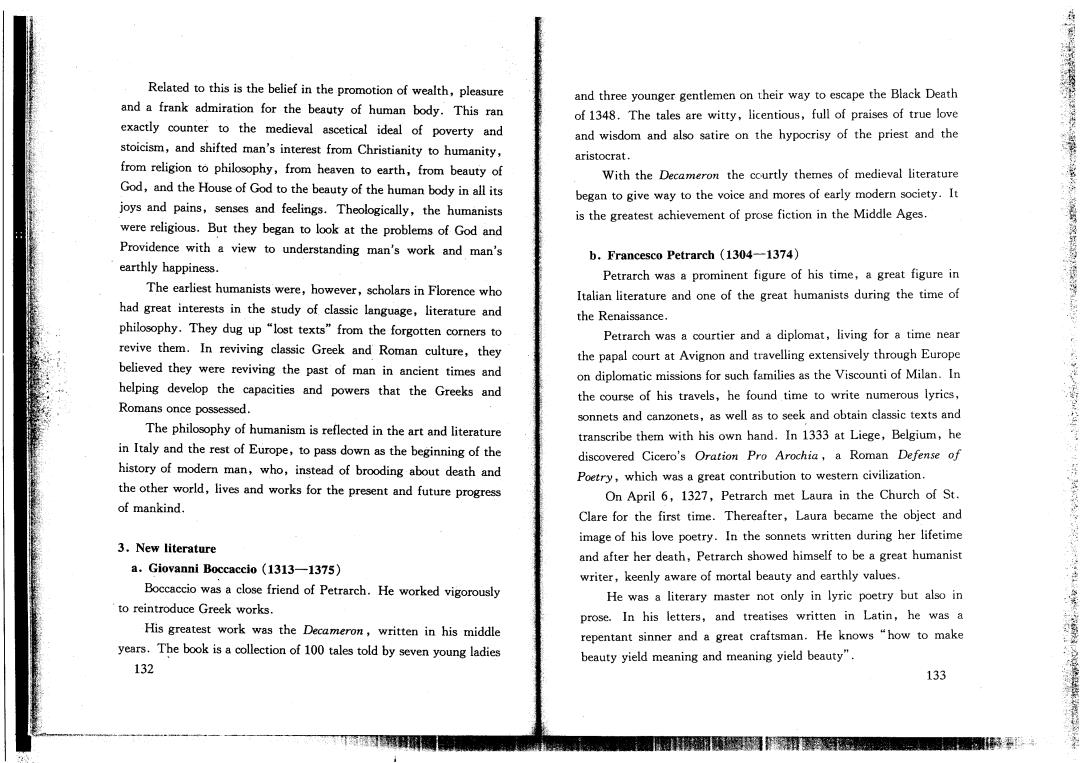
Related to this is the belief in the promotion of wealth,pleasure and three younger gentlemen on their way to escape the Black Death and a frank admiration for the beauty of human body.This ran of 1348.The tales are witty,licentious,full of praises of true love exactly counter to the medieval ascetical ideal of poverty and and wisdom and also satire on the hypocrisy of the priest and the stoicism,and shifted man's interest from Christianity to humanity, aristocrat. from religion to philosophy,from heaven to earth,from beauty of With the Decameron the courtly themes of medieval literature God,and the House of God to the beauty of the human body in all its began to give way to the voice and mores of early modern society.It joys and pains,senses and feelings.Theologically,the humanists is the greatest achievement of prose fiction in the Middle Ages. were religious.But they began to look at the problems of God and Providence with a view to understanding man's work and man's b.Francesco Petrarch (1304-1374) earthly happiness. Petrarch was a prominent figure of his time,a great figure in The earliest humanists were,however,scholars in Florence who Italian literature and one of the great humanists during the time of had great interests in the study of classic language,literature and the Renaissance. philosophy.They dug up "lost texts"from the forgotten corners to Petrarch was a courtier and a diplomat,living for a time near revive them.In reviving classic Greek and Roman culture,they the papal court at Avignon and travelling extensively through Europe believed they were reviving the past of man in ancient times and on diplomatic missions for such families as the Viscounti of Milan.In helping develop the capacities and powers that the Greeks and the course of his travels,he found time to write numerous lyrics, Romans once possessed. sonnets and canzonets,as well as to seek and obtain classic texts and The philosophy of humanism is reflected in the art and literature transcribe them with his own hand.In 1333 at Liege,Belgium,he in Italy and the rest of Europe,to pass down as the beginning of the discovered Cicero's Oration Pro Arochia,a Roman Defense of history of modern man,who,instead of brooding about death and Poetry,which was a great contribution to western civilization. the other world,lives and works for the present and future progress On April 6,1327,Petrarch met Laura in the Church of St. of mankind. Clare for the first time.Thereafter,Laura became the object and image of his love poetry.In the sonnets written during her lifetime 3.New literature and after her death,Petrarch showed himself to be a great humanist a.Giovanni Boccaccio (1313-1375) writer,keenly aware of mortal beauty and earthly values. Boccaccio was a close friend of Petrarch.He worked vigorously He was a literary master not only in lyric poetry but also in to reintroduce Greek works. prose.In his letters,and treatises written in Latin,he was a His greatest work was the Decameron,written in his middle repentant sinner and a great craftsman.He knows "how to make years.The book is a collection of 100 tales told by seven young ladies beauty yield meaning and meaning yield beauty". 132 133 稀得
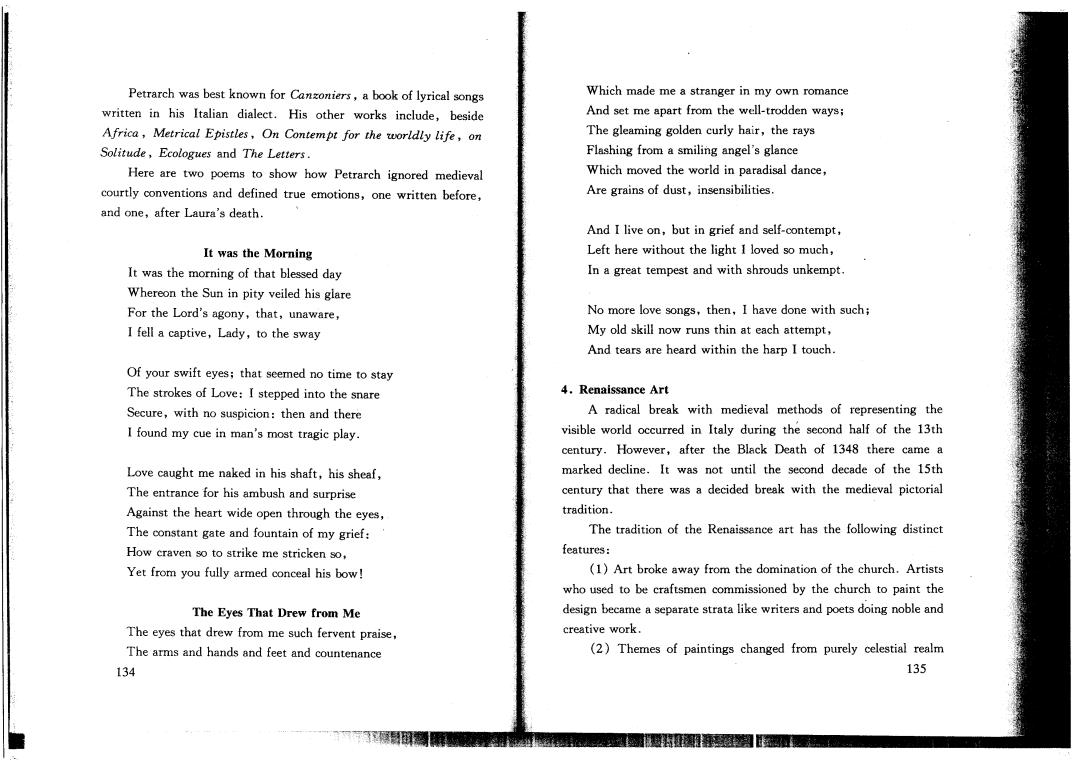
Petrarch was best known for Canzoniers,a book of lyrical songs Which made me a stranger in my own romance written in his Italian dialect.His other works include,beside And set me apart from the well-trodden ways; Africa,Metrical Epistles,On Contempt for the worldly life,on The gleaming golden curly hair,the rays Solitude,Ecologues and The Letters. Flashing from a smiling angel's glance Here are two poems to show how Petrarch ignored medieval Which moved the world in paradisal dance, courtly conventions and defined true emotions,one written before, Are grains of dust,insensibilities. and one,after Laura's death. And I live on,but in grief and self-contempt, It was the Morning Left here without the light I loved so much, It was the morning of that blessed day In a great tempest and with shrouds unkempt. Whereon the Sun in pity veiled his glare For the Lord's agony,that,unaware, No more love songs,then,I have done with such; I fell a captive,Lady,to the sway My old skill now runs thin at each attempt, And tears are heard within the harp I touch. Of your swift eyes;that seemed no time to stay The strokes of Love:I stepped into the snare 4.Renaissance Art Secure,with no suspicion:then and there A radical break with medieval methods of representing the I found my cue in man's most tragic play. visible world occurred in Italy during the second half of the 13th century.However,after the Black Death of 1348 there came a Love caught me naked in his shaft,his sheaf, marked decline.It was not until the second decade of the 15th The entrance for his ambush and surprise century that there was a decided break with the medieval pictorial Against the heart wide open through the eyes, tradition. The constant gate and fountain of my grief: The tradition of the Renaissance art has the following distinct How craven so to strike me stricken so, features: Yet from you fully armed conceal his bow! (1)Art broke away from the domination of the church.Artists who used to be craftsmen commissioned by the church to paint the The Eyes That Drew from Me design became a separate strata like writers and poets doing noble and The eyes that drew from me such fervent praise, creative work. The arms and hands and feet and countenance (2)Themes of paintings changed from purely celestial realm 134 135
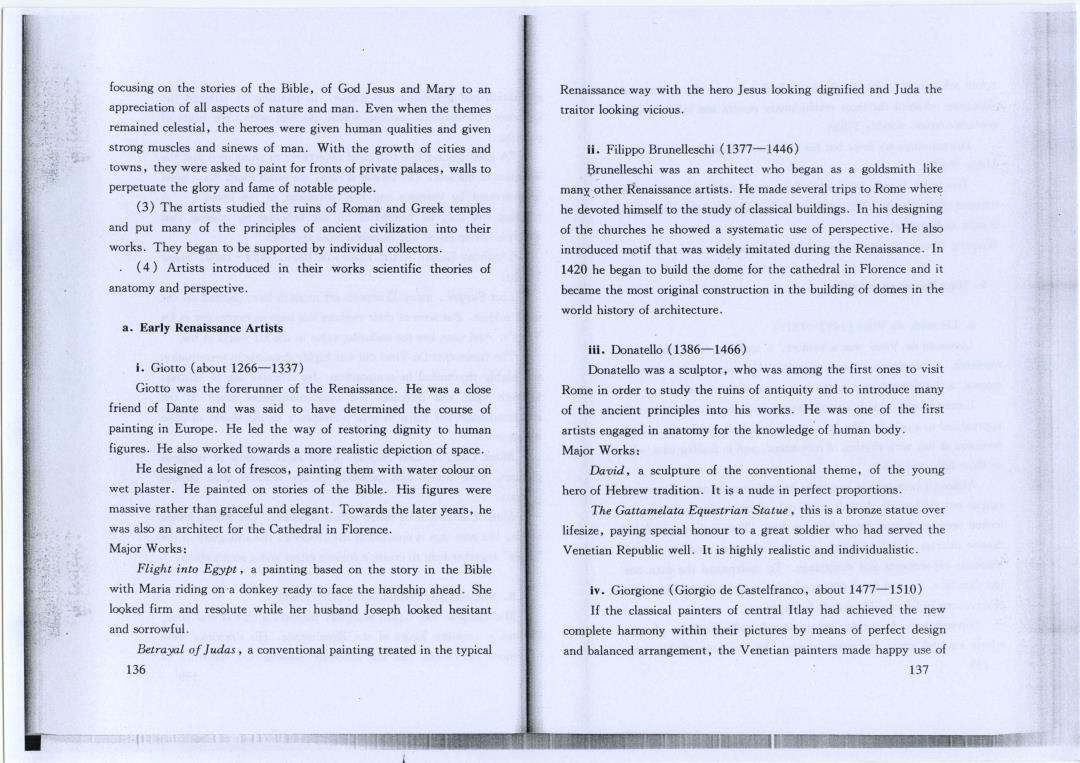
focusing on the stories of the Bible,of God Jesus and Mary to an Renaissance way with the hero Jesus looking dignified and Juda the appreciation of all aspects of nature and man.Even when the themes traitor looking vicious. remained celestial,the heroes were given human qualities and given strong muscles and sinews of man.With the growth of cities and ii.Filippo Brunelleschi (1377-1446) towns,they were asked to paint for fronts of private palaces,walls to Brunelleschi was an architect who began as a goldsmith like perpetuate the glory and fame of notable people. many other Renaissance artists.He made several trips to Rome where (3)The artists studied the ruins of Roman and Greek temples he devoted himself to the study of classical buildings.In his designing and put many of the principles of ancient civilization into their of the churches he showed a systematic use of perspective.He also works.They began to be supported by individual collectors. introduced motif that was widely imitated during the Renaissance.In (4)Artists introduced in their works scientific theories of 1420 he began to build the dome for the cathedral in Florence and it anatomy and perspective. became the most original construction in the building of domes in the world history of architecture. a.Early Renaissance Artists iii.Donatello (1386-1466) i.Giotto (about 1266-1337) Donatello was a sculptor,who was among the first ones to visit Giotto was the forerunner of the Renaissance.He was a close Rome in order to study the ruins of antiquity and to introduce many friend of Dante and was said to have determined the course of of the ancient principles into his works.He was one of the first painting in Europe.He led the way of restoring dignity to human artists engaged in anatomy for the knowledge of human body. figures.He also worked towards a more realistic depiction of space. Major Works: He designed a lot of frescos,painting them with water oolour on David,a sculpture of the conventional theme,of the young wet plaster.He painted on stories of the Bible.His figures were hero of Hebrew tradition.It is a nude in perfect proportions. massive rather than graceful and elegant.Towards the later years,he The Gattamelata Equestrian Statue,this is a bronze statue over was also an architect for the Cathedral in Florence. lifesize,paying special honour to a great soldier who had served the Major Works: Venetian Republic well.It is highly realistic and individualistic. Flight into Egypt,a painting based on the story in the Bible with Maria riding on a donkey ready to face the hardship ahead.She iv.Giorgione (Giorgio de Castelfranco,about 1477-1510) looked firm and resolute while her husband Joseph looked hesitant If the classical painters of central Itlay had achieved the new and sorrowful. complete harmony within their pictures by means of perfect design Betrayal of Judas,a conventional painting treated in the typical and balanced arrangement,the Venetian painters made happy use of 136 137
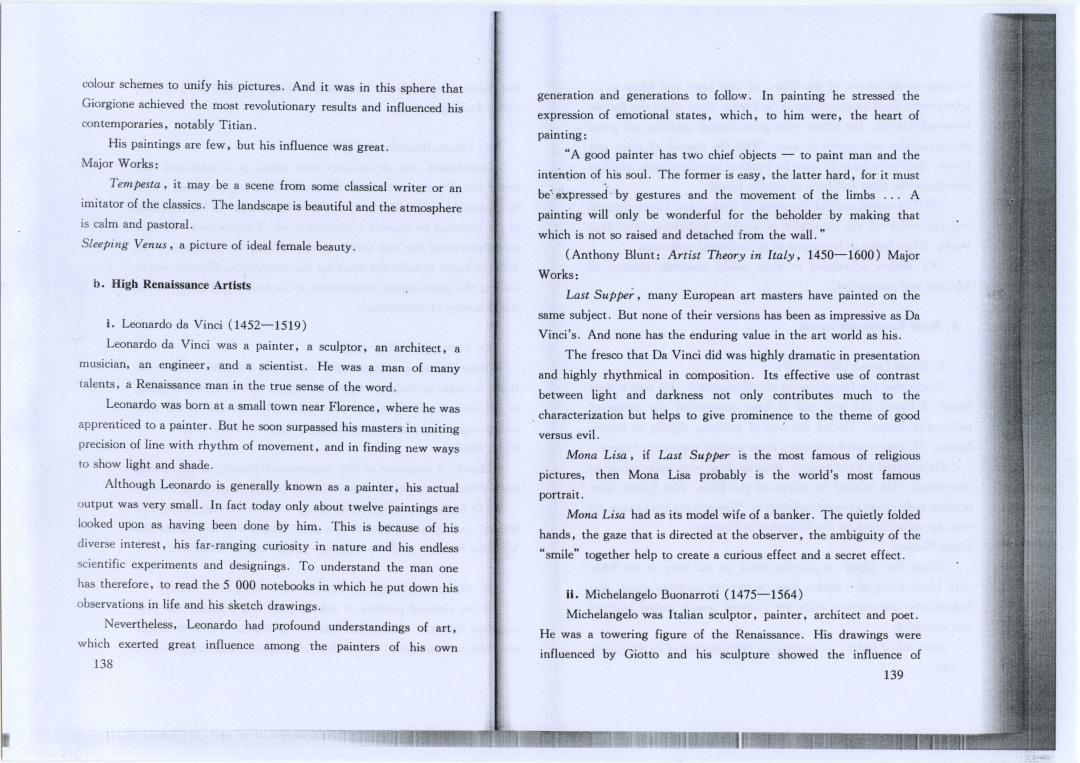
colour schemes to unify his pictures.And it was in this sphere that Giorgione achieved the most revolutionary results and influenced his generation and generations to follow.In painting he stressed the contemporaries,notably Titian. expression of emotional states,which,to him were,the heart of His paintings are few,but his influence was great. painting: Major Works: "A good painter has two chief objects-to paint man and the Tempesta,it may be a scene from some classical writer or an intention of his soul.The former is easy,the latter hard,for it must imitator of the classics.The landscape is beautiful and the atmosphere be'expressed by gestures and the movement of the limbs...A is calm and pastoral. painting will only be wonderful for the beholder by making that which is not so raised and detached from the wall." Sleeping Venus,a picture of ideal female beauty. (Anthony Blunt:Artist Theory in Italy,1450-1600)Major b.High Renaissance Artists Works: Last Supper,many European art masters have painted on the 1.Leonardo da Vinci (1452-1519) same subject.But none of their versions has been as impressive as Da Leonardo da Vinci was a painter,a sculptor,an architect,a Vinci's.And none has the enduring value in the art world as his. musician,an engineer,and a scientist.He was a man of many The fresco that Da Vinci did was highly dramatic in presentation talents,a Renaissance man in the true sense of the word. and highly rhythmical in composition.Its effective use of contrast Leonardo was born at a small town near Florence,where he was between light and darkness not only contributes much to the apprenticed to a painter.But he soon surpassed his masters in uniting characterization but helps to give prominence to the theme of good versus evil. precision of line with rhythm of movement,and in finding new ways to show light and shade. Mona Lisa,if Last Supper is the most famous of religious Although Leonardo is generally known as a painter,his actual pictures,then Mona Lisa probably is the world's most famous portrait. output was very small.In fact today only about twelve paintings are looked upon as having been done by him.This is because of his Mona Lisa had as its model wife of a banker.The quietly folded diverse interest,his far-ranging curiosity in nature and his endless hands,the gaze that is directed at the observer,the ambiguity of the scientific experiments and designings.To understand the man one "smile"together help to create a curious effect and a secret effect. has therefore,to read the 5 000 notebooks in which he put down his ii.Michelangelo Buonarroti (1475-1564) observations in life and his sketch drawings. Nevertheless,Leonardo had profound understandings of art, Michelangelo was Italian sculptor,painter,architect and poet. which exerted great influence among the painters of his own He was a towering figure of the Renaissance.His drawings were 138 influenced by Giotto and his sculpture showed the influence of 139
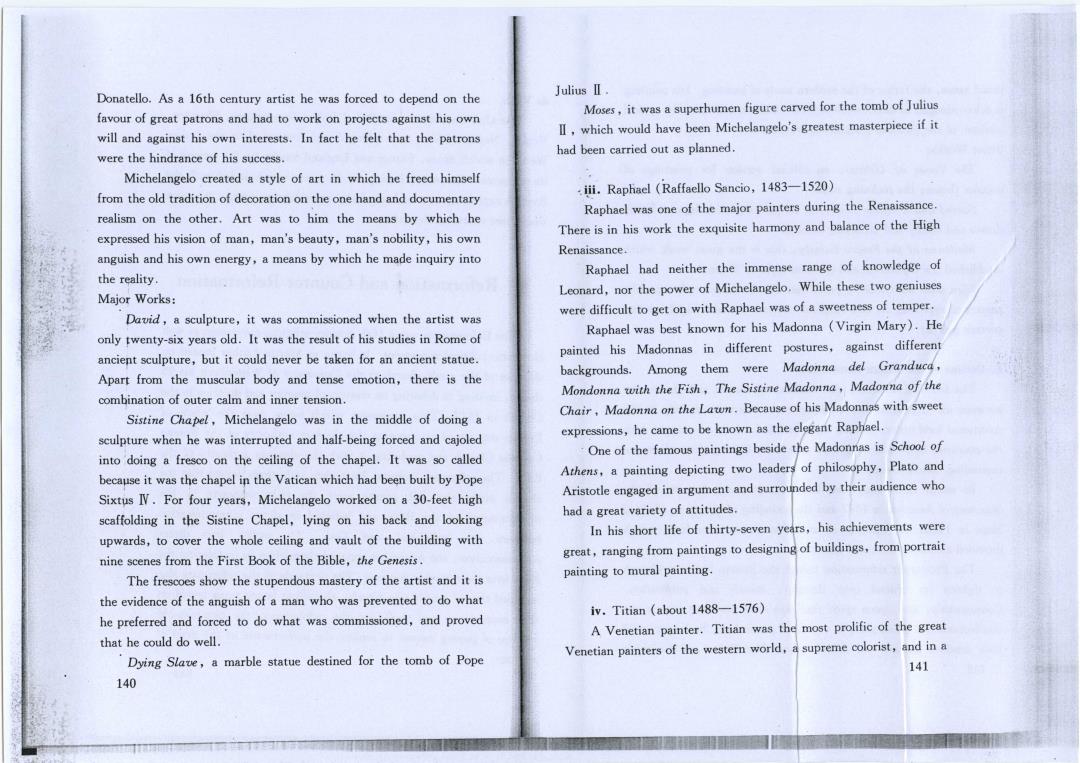
Donatello.As a 16th century artist he was forced to depend on the JuliusⅡ. Moses,it was a superhumen figure carved for the tomb of Julius favour of great patrons and had to work on projects against his own will and against his own interests.In fact he felt that the patrons II,which would have been Michelangelo's greatest masterpiece if it were the hindrance of his success. had been carried out as planned. Michelangelo created a style of art in which he freed himself from the old tradition of decoration on the one hand and documentary .iii.Raphael (Raffaello Sancio,1483-1520) Raphael was one of the major painters during the Renaissance. realism on the other.Art was to him the means by which he There is in his work the exquisite harmony and balance of the High expressed his vision of man,man's beauty,man's nobility,his own Renaissance. anguish and his own energy,a means by which he made inquiry into the reality. Raphael had neither the immense range of knowledge of Major Works: Leonard,nor the power of Michelangelo.While these two geniuses were difficult to get on with Raphael was of a sweetness of temper. David,a sculpture,it was commissioned when the artist was only twenty-six years old.It was the result of his studies in Rome of Raphael was best known for his Madonna(Virgin Mary).He ancient sculpture,but it could never be taken for an ancient statue. painted his Madonnas in different postures,against different backgrounds.Among them were Madonna del Granducd, Apart from the muscular body and tense emotion,there is the Mondonna with the Fish,The Sistine Madonna,Madonna of the combination of outer calm and inner tension. Chair,Madonna on the Lawn.Because of his Madonnas with sweet Sistine Chapel,Michelangelo was in the middle of doing a sculpture when he was interrupted and half-being forced and cajoled expressions,he came to be known as the elegant Raphael. into doing a fresco on the ceiling of the chapel.It was so called One of the famous paintings beside the Madonnas is School of because it was the chapel in the Vatican which had been built by Pope Athens,a painting depicting two leaders of philosophy,Plato and Sixtus IV.For four years,Michelangelo worked on a 30-feet high Aristotle engaged in argument and surrounded by their audience who scaffolding in the Sistine Chapel,lying on his back and looking had a great variety of attitudes. In his short life of thirty-seven years,his achievements were upwards,to cover the whole ceiling and vault of the building with nine scenes from the First Book of the Bible,the Genesis. great,ranging from paintings to designing of buildings,from portrait painting to mural painting. The frescoes show the stupendous mastery of the artist and it is the evidence of the anguish of a man who was prevented to do what he preferred and forced to do what was commissioned,and proved iv.Titian (about 1488-1576) A Venetian painter.Titian was the most prolific of the great that he could do well. Venetian painters of the western world,a supreme colorist,and in a Dying Slave,a marble statue destined for the tomb of Pope 141 140
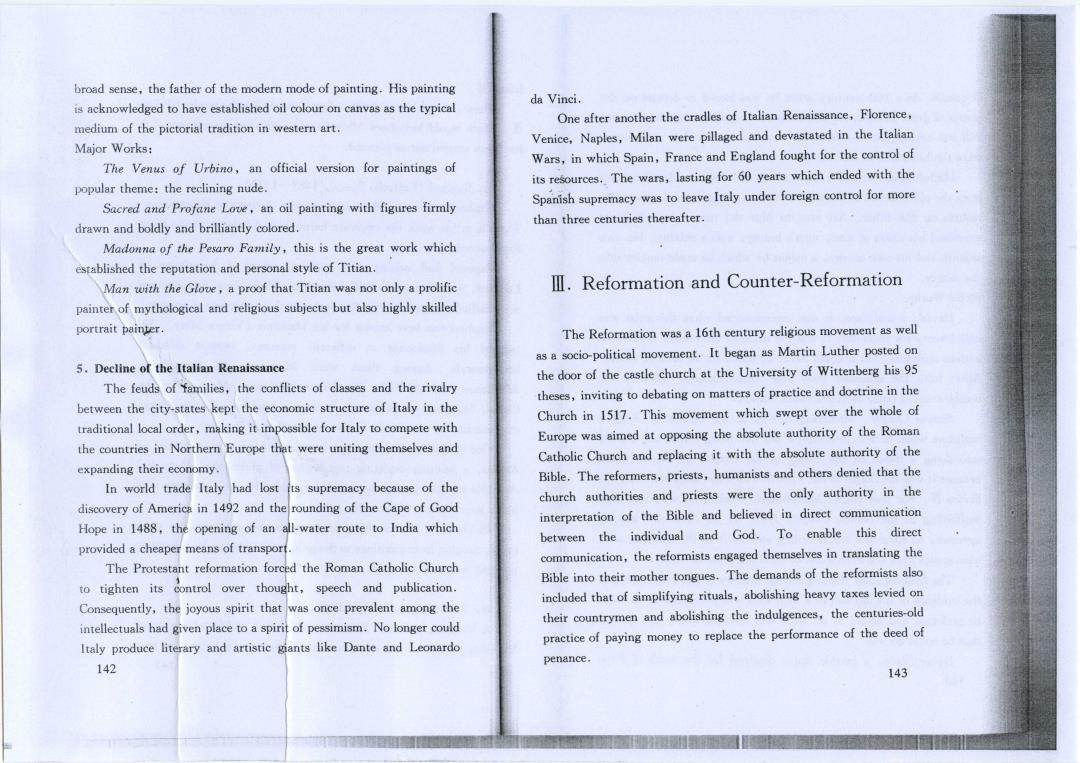
broad sense,the father of the modern mode of painting.His painting da Vinci. is acknowledged to have established oil colour on canvas as the typical One after another the cradles of Italian Renaissance,Florence, medium of the pictorial tradition in western art. Venice,Naples,Milan were pillaged and devastated in the Italian Major Works: Wars,in which Spain,France and England fought for the control of The Venus of Urbino,an official version for paintings of its resources.The wars,lasting for 60 years which ended with the popular theme:the reclining nude. Spanish supremacy was to leave Italy under foreign control for more Sacred and Profane Love,an oil painting with figures firmly than three centuries thereafter. drawn and boldly and brilliantly colored. Madonna of the Pesaro Family,this is the great work which established the reputation and personal style of Titian. Man with the Glove,a proof that Titian was not only a prolific IlI.Reformation and Counter-Reformation painter of mythological and religious subjects but also highly skilled portrait painter. The Reformation was a 16th century religious movement as well as a socio-political movement.It began as Martin Luther posted on 5.Decline of the Italian Renaissance the door of the castle church at the University of Wittenberg his 95 The feuds of families,the conflicts of classes and the rivalry theses,inviting to debating on matters of practice and doctrine in the between the city-states kept the economic structure of Italy in the Church in 1517.This movement which swept over the whole of traditional local order,making it impossible for Italy to compete with Europe was aimed at opposing the absolute authority of the Roman the countries in Northern Europe that were uniting themselves and Catholic Church and replacing it with the absolute authority of the expanding their economy. Bible.The reformers,priests,humanists and others denied that the In world trade Italy had lost its supremacy because of the church authorities and priests were the only authority in the discovery of America in 1492 and therounding of the Cape of Good interpretation of the Bible and believed in direct communication Hope in 1488,the opening of an all-water route to India which between the individual and God.To enable this direct provided a cheaper means of transport. communication,the reformists engaged themselves in translating the The Protestant reformation forced the Roman Catholic Church to tighten its control over thought,speech and publication. Bible into their mother tongues.The demands of the reformists also included that of simplifying rituals,abolishing heavy taxes levied on Consequently,the joyous spirit that was once prevalent among the their countrymen and abolishing the indulgences,the centuries-old intellectuals had given place to a spirit of pessimism.No longer could Italy produce literary and artistic giants like Dante and Leonardo practice of paying money to replace the performance of the deed of penance. 142 143
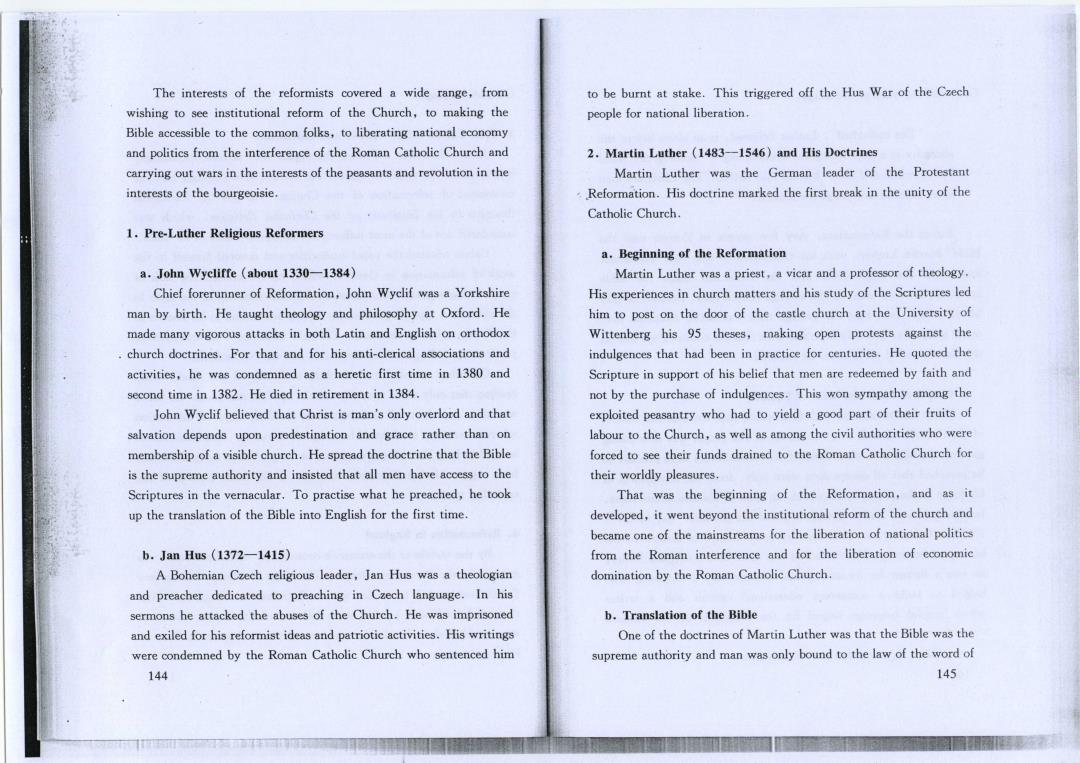
The interests of the reformists covered a wide range,from to be burnt at stake.This triggered off the Hus War of the Czech wishing to see institutional reform of the Church,to making the people for national liberation. Bible accessible to the common folks,to liberating national economy and politics from the interference of the Roman Catholic Church and 2.Martin Luther (1483-1546)and His Doctrines carrying out wars in the interests of the peasants and revolution in the Martin Luther was the German leader of the Protestant interests of the bourgeoisie. Reformation.His doctrine marked the first break in the unity of the Catholic Church 1.Pre-Luther Religious Reformers a.Beginning of the Reformation a.John Wycliffe (about 1330-1384) Martin Luther was a priest,a vicar and a professor of theology. Chief forerunner of Reformation,John Wyclif was a Yorkshire His experiences in church matters and his study of the Scriptures led man by birth.He taught theology and philosophy at Oxford.He him to post on the door of the castle church at the University of made many vigorous attacks in both Latin and English on orthodox Wittenberg his 95 theses,making open protests against the church doctrines.For that and for his anti-clerical associations and indulgences that had been in practice for centuries.He quoted the activities,he was condemned as a heretic first time in 1380 and Scripture in support of his belief that men are redeemed by faith and second time in 1382.He died in retirement in 1384. not by the purchase of indulgences.This won sympathy among the John Wyclif believed that Christ is man's only overlord and that exploited peasantry who had to yield a good part of their fruits of salvation depends upon predestination and grace rather than on labour to the Church,as well as among the civil authorities who were membership of a visible church.He spread the doctrine that the Bible forced to see their funds drained to the Roman Catholic Church for is the supreme authority and insisted that all men have access to the their worldly pleasures. Scriptures in the vernacular.To practise what he preached,he took That was the beginning of the Reformation,and as it up the translation of the Bible into English for the first time. developed,it went beyond the institutional reform of the church and became one of the mainstreams for the liberation of national politics b.Jan Hus(1372-1415) from the Roman interference and for the liberation of economic A Bohemian Czech religious leader,Jan Hus was a theologian domination by the Roman Catholic Church. and preacher dedicated to preaching in Czech language.In his sermons he attacked the abuses of the Church.He was imprisoned b.Translation of the Bible and exiled for his reformist ideas and patriotic activities.His writings One of the doctrines of Martin Luther was that the Bible was the were condemned by the Roman Catholic Church who sentenced him supreme authority and man was only bound to the law of the word of 144 145
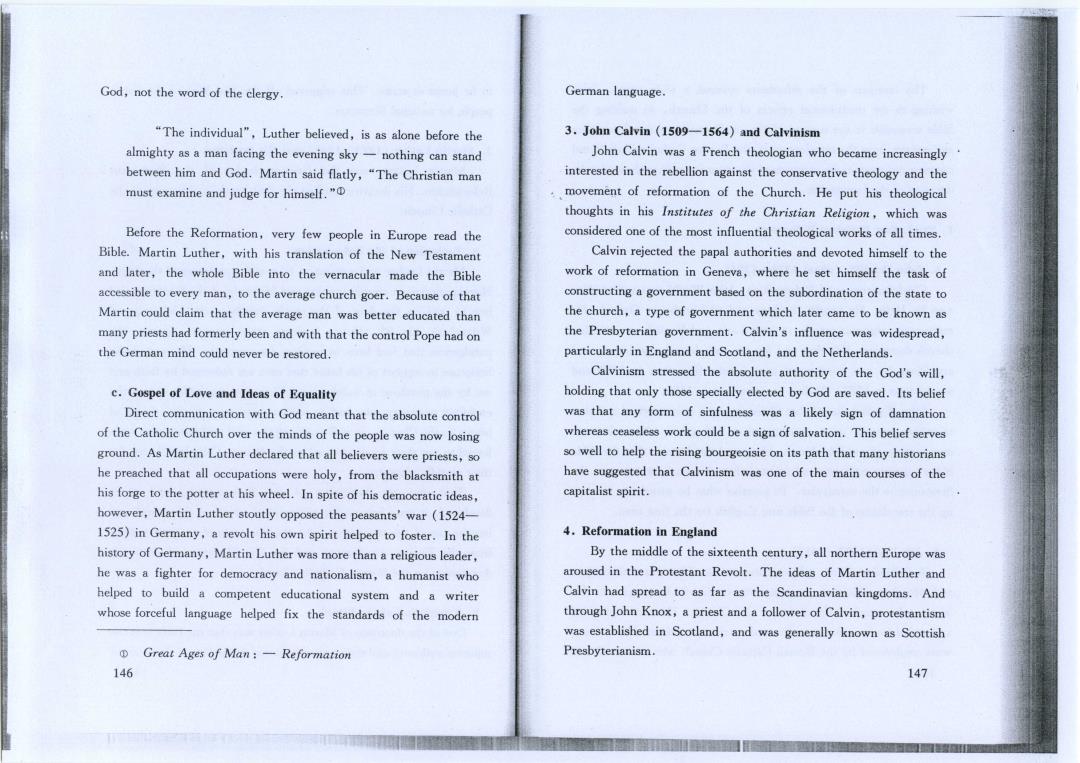
God,not the word of the clergy. German language "The individual",Luther believed,is as alone before the 3.John Calvin (1509-1564)and Calvinism almighty as a man facing the evening sky-nothing can stand John Calvin was a French theologian who became increasingly between him and God.Martin said flatly,"The Christian man interested in the rebellion against the conservative theology and the must examine and judge for himself." movement of reformation of the Church.He put his theological thoughts in his Institutes of the Christian Religion,which was Before the Reformation,very few people in Europe read the considered one of the most influential theological works of all times. Bible.Martin Luther,with his translation of the New Testament Calvin rejected the papal authorities and devoted himself to the and later,the whole Bible into the vernacular made the Bible work of reformation in Geneva,where he set himself the task of accessible to every man,to the average church goer.Because of that constructing a government based on the subordination of the state to Martin could claim that the average man was better educated than the church,a type of government which later came to be known as many priests had formerly been and with that the control Pope had on the Presbyterian government.Calvin's influence was widespread, the German mind could never be restored. particularly in England and Scotland,and the Netherlands Calvinism stressed the absolute authority of the God's will, c.Gospel of Love and Ideas of Equality holding that only those specially elected by God are saved.Its belief Direct communication with God meant that the absolute control was that any form of sinfulness was a likely sign of damnation of the Catholic Church over the minds of the people was now losing whereas ceaseless work could be a sign of salvation.This belief serves ground.As Martin Luther declared that all believers were priests,so so well to help the rising bourgeoisie on its path that many historians he preached that all occupations were holy,from the blacksmith at have suggested that Calvinism was one of the main courses of the his forge to the potter at his wheel.In spite of his democratic ideas, capitalist spirit. however,Martin Luther stoutly opposed the peasants'war(1524- 1525)in Germany,a revolt his own spirit helped to foster.In the 4.Reformation in England history of Germany,Martin Luther was more than a religious leader, By the middle of the sixteenth century,all northern Europe was he was a fighter for democracy and nationalism,a humanist who aroused in the Protestant Revolt.The ideas of Martin Luther and helped to build a competent educational system and a writer Calvin had spread to as far as the Scandinavian kingdoms.And whose forceful language helped fix the standards of the modern through John Knox,a priest and a follower of Calvin,protestantism was established in Scotland,and was generally known as Scottish D Great Ages of Man:-Reformation Presbyterianism. 146 147